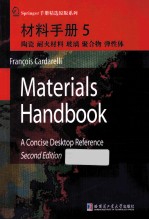图书介绍
材料手册 5 陶瓷、耐火材料、玻璃、聚合物、弹性体 英文版pdf电子书版本下载

- FrancoisCardarelli著 著
- 出版社: 哈尔滨:哈尔滨工业大学出版社
- ISBN:9787560344515
- 出版时间:2014
- 标注页数:750页
- 文件大小:40MB
- 文件页数:167页
- 主题词:材料科学-技术手册-英文
PDF下载
下载说明
材料手册 5 陶瓷、耐火材料、玻璃、聚合物、弹性体 英文版PDF格式电子书版下载
下载的文件为RAR压缩包。需要使用解压软件进行解压得到PDF格式图书。建议使用BT下载工具Free Download Manager进行下载,简称FDM(免费,没有广告,支持多平台)。本站资源全部打包为BT种子。所以需要使用专业的BT下载软件进行下载。如 BitComet qBittorrent uTorrent等BT下载工具。迅雷目前由于本站不是热门资源。不推荐使用!后期资源热门了。安装了迅雷也可以迅雷进行下载!
(文件页数 要大于 标注页数,上中下等多册电子书除外)
注意:本站所有压缩包均有解压码: 点击下载压缩包解压工具
图书目录
Introduction 15
10 Ceramics,Refractories,and Glasses 593
10.1 Introduction and Definitions 593
10.2 Raw Materials for Ceramics,Refractories and Glasses 594
10.2.1 Silica 594
10.2.1.1 Quartz,Quartzite,and Silica Sand 595
10.2.1.2 Diatomite 595
10.2.1.3 Fumed Silica 595
10.2.1.4 Silica Gels and Sol-Gel Silica 595
10.2.1.5 Precipitated Silica 595
10.2.1.6 Microsilica 596
10.2.1.7 Vitreous or Amorphous Silica 596
10.2.2 Aluminosilicates 596
10.2.2.1 Fireclay 597
10.2.2.2 China Clay 598
10.2.2.3 Ball Clay 598
10.2.2.4 Other Refractory Clays 599
10.2.2.5 Andalusite,Kyanite,and Sillimanite 599
10.2.2.6 Mullite 600
10.2.3 Bauxite and Aluminas 600
10.2.3.1 Bauxite 600
10.2.3.2 Alumina Hydrates 603
10.2.3.3 Transition Aluminas(TrA) 606
10.2.3.4 Calcined Alumina 606
10.2.3.5 Tabular Alumina 607
10.2.3.6 White Fused Alumina 608
10.2.3.7 Brown Fused Alumina 608
10.2.3.8 Electrofused Alumina-Zirconia 609
10.2.3.9 High-Purity Alumina 609
10.2.4 Limestone and Lime 610
10.2.5 Dolomite and Doloma 610
10.2.5.1 Dolomite 610
10.2.5.2 Calcined and Dead Burned Dolomite(Doloma) 611
10.2.6 Magnesite and Magnesia 612
10.2.6.1 Magnesite 612
10.2.6.2 Caustic Seawater and Calcined Magnesia 612
10.2.6.3 Dead Burned Magnesia 613
10.2.6.4 Electrofused Magnesia 614
10.2.6.5 Seawater Magnesia Clinker 614
10.2.7 Titania 614
10.2.7.1 Rutile 614
10.2.7.2 Anatase 616
10.2.7.3 Brookite 616
10.2.7.4 Anosovite 616
10.2.7.5 Titanium Sesquioxide 617
10.2.7.6 Titanium Monoxide or Hongquiite 617
10.2.7.7 Titanium Hemioxide 618
10.2.7.8 Andersson-Magnéli Phases 618
10.2.8 Zircon and Zirconia 618
10.2.8.1 Zircon 618
10.2.8.2 Zirconia 618
10.2.9 Carbon and Graphite 623
10.2.9.1 Description and General Properties 623
10.2.9.2 Natural Occurrence and Mining 623
10.2.9.3 Industrial Preparation and Processing 625
10.2.9.4 Industrial Applications and Uses 625
10.2.10 Silicon Carbide 625
10.2.10.1 Description and General Properties 625
10.2.10.2 Industrial Preparation 626
10.2.10.3 Grades of Silicon Carbide 628
10.2.11 Properties of Raw Materials Used in Ceramics,Refractories,and Glasses 628
10.3 Traditional Ceramics 629
10.4 Refractories 630
10.4.1 Classification of Refractories 630
10.4.2 Properties of Refractories 631
10.4.3 Major Refractory Manufacturers 634
10.5 Advanced Ceramics 635
10.5.1 Silicon Nitride 635
10.5.1.1 Description and General Properties 635
10.5.1.2 Industrial Preparation and Grades 635
10.5.2 Silicon Aluminum Oxynitride(SiAlON) 636
10.5.3 Boron Carbide 637
10.5.3.1 Description and General Properties 637
10.5.3.2 Industrial Preparation 637
10.5.3.3 Industrial Applications and Uses 637
10.5.4 Boron Nitride 637
10.5.4.1 Description and General Properties 637
10.5.4.2 Industrial Preparation 638
10.5.4.3 Industrial Applications and Uses 638
10.5.5 Titanium Diboride 638
10.5.5.1 Description and General Properties 638
10.5.5.2 Industrial Preparation and Processing 639
10.5.5.3 Industrial Applications and Uses 639
10.5.6 Tungsten Carbides and Hardmetal 639
10.5.6.1 Description and General Properties 639
10.5.6.2 Industrial Preparation 640
10.5.6.3 Industrial Applications and Uses 640
10.5.7 Practical Data for Ceramists and Refractory Engineers 641
10.5.7.1 Temperature of Color 641
10.5.7.2 Pyrometric Cone Equivalents 641
10.6 Standards for Testing Refractories 643
10.7 Properties of Pure Ceramics(Borides,Carbides,Nitrides,Silicides,and Oxides) 647
10.8 Further Reading 670
10.8.1 Traditional and Advanced Ceramics 670
10.8.2 Refractories 670
10.9 Glasses 671
10.9.1 Definitions 671
10.9.2 Physical Properties of Glasses 671
10.9.3 Glassmaking Processes 671
10.9.4 Further Reading 676
10.10 Proppants 677
10.10.1 Fracturing Techniques in Oil-Well Production 677
10.10.1.1 Hydraulic Fracturing 677
10.10.1.2 Pressure Acidizing 678
10.10.2 Proppant and Frac Fluid Selection Criteria 678
10.10.2.1 Proppant Materials 678
10.10.2.2 Frac Fluids 679
10.10.2.3 Properties and Characterization of Proppants 679
10.10.2.4 Classification of Proppant Materials 679
10.10.2.5 Production of Synthetic Proppants 682
10.10.2.6 Properties of Commercial Proppants 683
10.10.2.7 Proppant Market 687
10.10.2.8 Proppant Producers 687
10.10.3 Further Reading 689
11 Polymers and Elastomers 691
11.1 Fundamentals and Definitions 691
11.1.1 Definitions 691
11.1.2 Additives and Fillers 692
11.1.3 Polymerization and Polycondensation 693
11.2 Properties and Characteristics of Polymers 694
11.2.1 Molar Mass and Relative Molar Mass 694
11.2.2 Average Degree of Polymerization 695
11.2.3 Number-,Mass-and Z-Average Molar Masses 695
11.2.4 Glass Transition Temperature 697
11.2.5 Structure of Polymers 697
11.3 Classification of Plastics and Elastomers 697
11.4 Thermoplastics 697
11.4.1 Naturally Occurring Resins 697
11.4.1.1 Rosin 697
11.4.1.2 Shellac 699
11.4.2 Cellulosics 699
11.4.2.1 Cellulose Nitrate 699
11.4.2.2 Cellulose Acetate(CA) 700
11.4.2.3 Cellulose Propionate(CP) 700
11.4.2.4 Cellulose Xanthate 700
11.4.2.5 Alkylcelluloses 701
11.4.3 Casein Plastics 701
11.4.4 Coumarone-Indene Plastics 702
11.4.5 Polyolefins or Ethenic Polymers 702
11.4.5.1 Polyethylene(PE) 702
11.4.5.2 Polypropylene(PP) 703
11.4.5.3 Polybutylene(PB) 704
11.4.6 Polymethylpentene(PMP) 704
11.4.7 Polyvinyl Plastics 704
11.4.7.1 Polyvinyl Chlorides(PVCs) 704
11.4.7.2 Chlorinated Polyvinylchloride(CPVC) 705
11.4.7.3 Polyvinyl Fluoride(PVF) 705
11.4.7.4 Polyvinyl Acetate(PVA) 705
11.4.8 Polyvinylidene Plastics 705
11.4.8.1 Polyvinylidene Chloride(PVDC) 705
11.4.8.2 Polyvinylidene Fluoride(PVDF) 706
11.4.9 Styrenics 706
11.4.9.1 Polystyrene(PS) 706
11.4.9.2 Acrylonitrile Butadiene Styrene(ABS) 706
11.4.10 Fluorinated Polyolefins(Fluorocarbons) 707
11.4.10.1 Polytetrafluoroethylene(PTFE) 707
11.4.10.2 Fluorinated Ethylene Propylene(FEP) 708
11.4.10.3 Perfluorinated Alkoxy(PFA) 708
11.4.10.4 Polychlorotrifluoroethylene(PCTFE) 708
11.4.10.5 Ethylene-Chlorotrifluoroethylene Copolymer(ECTFE) 709
11.4.10.6 Ethylene-Tetrafluoroethylene Copolymer(ETFE) 709
11.4.11 Acrylics and Polymethyl Methacrylate(PMMA) 709
11.4.12 Polyamides(PA) 710
11.4.13 Polyaramides(PAR) 710
11.4.14 Polyimides(PI) 710
11.4.15 Polyacetals(PAc) 711
11.4.16 Polycarbonates(PC) 711
11.4.17 Polysulfone(PSU) 711
11.4.18 Polyphenylene Oxide(PPO) 712
11.4.19 Polyphenylene Sulfide(PPS) 712
11.4.20 Polybutylene Terephthalate(PBT) 712
11.4.21 PolyethyleneTerephthalate(PET) 712
11.4.22 Polydiallyl Phthalate(PDP) 713
11.5 Thermosets 713
11.5.1 Aminoplastics 713
11.5.2 Phenolics 714
11.5.3 Acrylonitrile-Butadiene-Styrene(ABS) 714
11.5.4 Polyurethanes(PUR) 715
11.5.5 Furan Plastics 715
11.5.6 Epoxy Resins(EP) 715
11.6 Rubbers and Elastomers 715
11.6.1 Natural Rubber(NR) 716
11.6.2 Trans-Polyisoprene Rubber(PIR) 716
11.6.3 Polybutadiene Rubber(BR) 716
11.6.4 Styrene Butadiene Rubber(SBR) 717
11.6.5 Nitrile Rubber(NR) 717
11.6.6 Butyl Rubber(IIR) 717
11.6.7 Chloroprene Rubber(CPR) 717
11.6.8 Chlorosulfonated Polyethylene(CSM) 718
11.6.9 Polysulfide Rubber(PSR) 718
11.6.10 Ethylene Propylene Rubbers 718
11.6.11 Silicone Rubber 719
11.6.12 Fluoroelastomers 719
11.7 Physical Properties of Polymers 720
11.8 Gas Permeability of Polymers 734
11.9 ChemicalResistance of Polymers 734
11.10 IUPAC Acronyms of Polymers and Elastomers 745
11.11 Economic Data on Polymers and Related Chemical Intermediates 746
11.11.1 Average Prices of Polymers 746
11.11.2 Production Capacities,Prices and Major Producers of Polymers and Chemical Intermediates 747
11.12 Further Reading 750